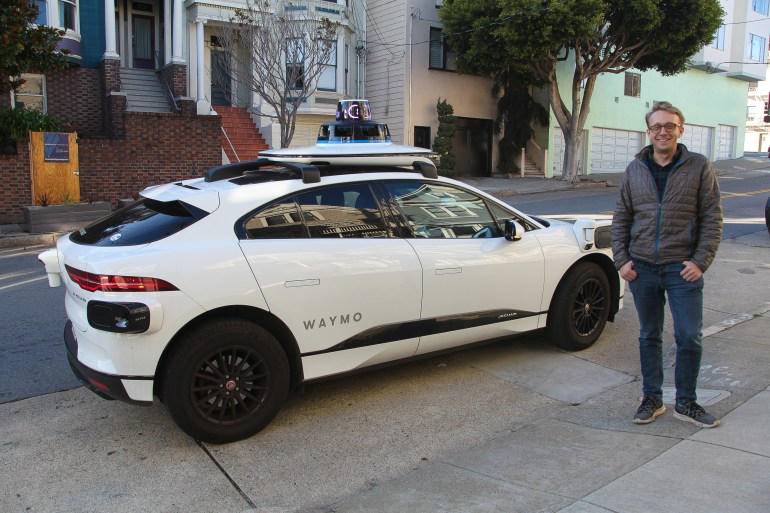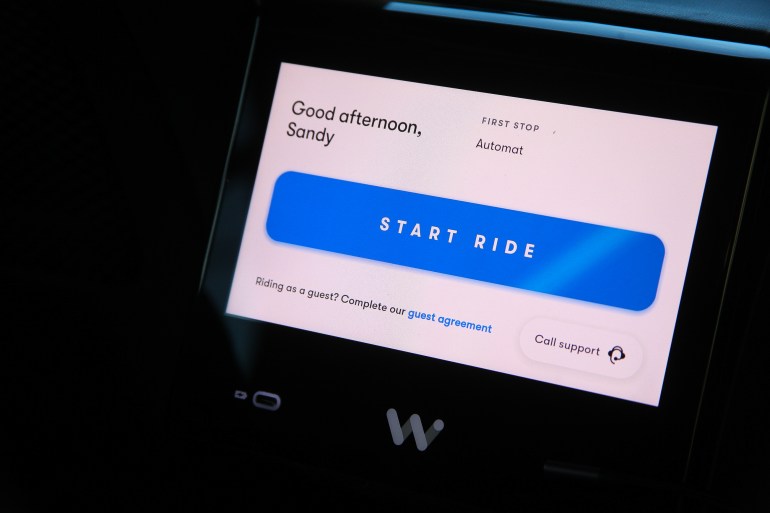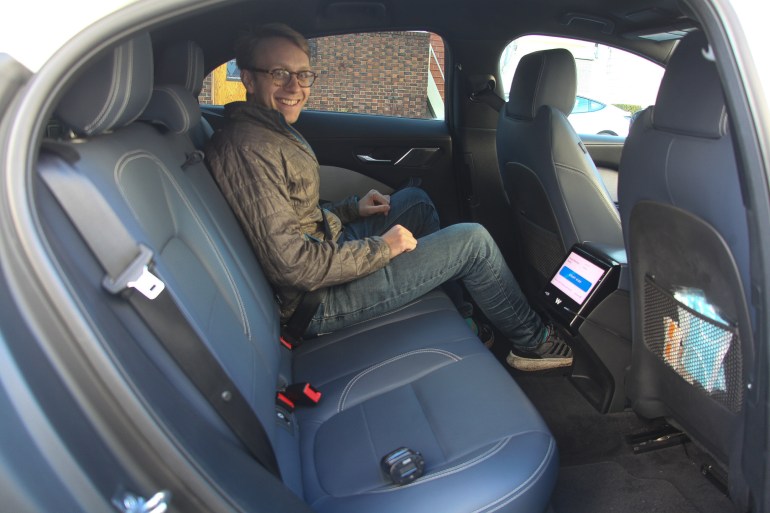On the road in San Francisco, riding in a driverless taxi
The minutes drip by, and still no sign of any public transportation. I’m running late. Perched on the edge of a curb, squinting down the length of Market Street in the US city of San Francisco, I find myself twitchily tapping my phone, only to wince as the time ticks away.
But suddenly the traffic parts. A faint bell rings on the horizon. And up the Market Street rail line rumbles my deliverance: a 1928 wood-panelled tram in green-and-white trim.
Oh, the irony: I’m headed to test out one of the city’s newest transportation options while creaking down the road on one of its oldest.
San Francisco has long been a hub for transportation innovation. It was here that the first cable car system was put into use. It was here that engineers built the longest suspension bridge of its age, the Golden Gate, a structure that would hold the record for nearly 27 years. And it is here, now, that a new horizon in transportation is being explored: self-driving cars.
Since June, the state of California has allowed fully autonomous vehicles to pick up passengers as part of a taxi-like service — without a human driver behind the wheel.
The first company to receive a permit for the pilot program was Cruise, a subsidiary of the US car giant General Motors. The second, approved just last month, was Waymo, a branch of Alphabet Inc, the same company that owns Google.
On December 16, Waymo expanded its driverless San Francisco service across the entire city, available at all hours of the day. Would-be riders can sign up to join a waitlist through Waymo’s app, with select riders offered a chance to join the “Trusted Tester” program to try out new features.

Driverless vehicles have been in the works for decades: General Motors famously unveiled its concept for cars driven through “automatic radio control” as far back as the 1939 New York World’s Fair.
But recent years have brought an increasing number of autonomous vehicles out of testing and onto real roadways, with all the variables that pedestrians, animals, bad weather and fellow motorists can throw their way.
The rollout has not been without hiccups. In 2018, a self-driving car in Arizona struck and killed a woman, in what is believed to be the first pedestrian death caused by an autonomous vehicle.
And a report from the US National Highway Traffic Safety Administration (NHTSA) this summer found 130 crashes involving “automated driving systems” from July 2021 to May 2022, though only one case resulted in “serious” injury. The vast majority of the crashes involved no injuries at all.
But collisions aren’t the only obstacle these driverless fleets have faced. In a document released Friday, the NHTSA announced it would start an investigation into reports of Cruise vehicles immobilising in the middle of traffic.
The San Francisco Examiner newspaper reported on one incident this past July where as many as 20 self-driving cars clustered at a single intersection — and simply stopped. Cruise employees arrived on the scene to move the vehicles, which were blocking southbound traffic.
The NHTSA warned that such incidents could not only strand passengers in unsafe locations but also force other vehicles to perform “abrupt” manoeuvres to avoid the stalled cars. The administration also noted that these “immobilisations” could prevent emergency vehicles from passing.

Living in San Francisco, I’d grown accustomed to seeing the driverless cars whirring around my neighbourhood, easily identifiable by the layer cake of cameras, servers and sensors fixed atop their roofs.
I’d even started to look forward to them. Each vehicle in Cruise’s fleet, for example, has a name painted on its side — and I relished the chance to spot the latest chi-chi moniker. A car named Biscotti once passed me on the way to the gym. Another named Cobalt breezed by on a late-night stroll.
But knowing the risk of immobilisations and crashes, was I ready to entrust my safety to some driverless car named Kombucha? Not quite. I set out to do more research first.
Madhur Behl, a computer science and engineering professor at the University of Virginia, has not only studied autonomous vehicles for six years: He races them. Behl and his students sent a fully autonomous car down the Indianapolis Motor Speedway last year at speeds of up to 199 kilometres an hour (124 mph).
“We are using racing as the proving ground, as the litmus test, to stress-test the AI [artificial intelligence] algorithms — to discover where are the limits of perception,” Behl told me via phone. “What better way to do this than in the high-speed, close-proximity sandbox that racing provides me?”
But when it comes to putting driverless vehicles in real-world environments, Behl expressed caution.
“The challenge today is, in my opinion, that we still cannot fully ensure that an autonomous vehicle will operate safely under the different, varying real-world conditions, right? Especially in situations that it has never encountered before,” he said.

With decades of development and millions of dollars at stake, Behl worries about the urgency “to prove the economics” of the vehicles.
“There’s a risk that you are pushing the deployment much faster than the improvements in the safety of the system are being made,” he said.
Part of the solution, Behl explained, lies in greater transparency. But currently, there is no federal mandate that would force companies to release a full suite of safety data.
“Essentially regulatory standards have not kept pace with the technological innovation,” he said. “The safety has to be auditable if they [the driverless cars] are being publicly deployed, and that’s not the case at present.”
Regulators also must grapple with defining what safe means when it comes to autonomous vehicles, Behl added. An estimated 1.3 million people die in motor vehicle accidents every year around the world. And it’s not just the safety of passengers that must be considered but that of bystanders, as well.
“The reasonable thing to say is that it should be better than a human driver,” Behl said of driverless technology. But then the question becomes: “Which human driver are you comparing to?”
I arrive at my destination in San Francisco’s Castro neighbourhood with Behl’s words fresh in my mind. There, in front of the local LGBTQ history museum, two people are waiting for me: Waymo communications manager Sandy Karp and her colleague, product manager Jack Wanderman.
They are there to accompany me on my first ride in a driverless vehicle.

I had waited weeks, unsuccessfully, to make it to the top of Waymo’s ride-service waitlist, and after reaching out to the company itself, Karp — a bright-eyed woman with curly brown hair — answered my appeal with an offer to use her own app to order up a test drive.
Straight away, she whips out her smartphone. Summoning a driverless vehicle is just like using any other ride-hailing app, she explains. She types our pick-up spot and destination into the Waymo app and hits the “request” button.
Suddenly a small splash of confetti bursts on her screen: Our ride is set to arrive in six minutes. What ultimately rolls up is a sleek, white Jaguar sport utility vehicle with an LED display mounted on top, flashing Karp’s initials.
At first, there seems to be no way to open the vehicle. Its door handles lie flattened against its sides. But with a tap to her phone, Karp unlocks the car — and the door handles pop out, ready for entry, like a two-dimensional drawing suddenly becoming 3D.
As we step inside, the empty car issues a chipper, if ghostly, greeting. “Hello Sandy,” it purrs. From the front seat, Karp flashes her phone screen in my direction: The car issues what she calls a “monologue”, updating users through the app about its whereabouts.

Wanderman and Karp invite me to do the honours: I tap the “start” button on the car’s internal screens to launch our ride. A female voice emanates from the car speakers in response.
“Heading to Automat,” she says, referencing to our destination, a restaurant in San Francisco’s NoPa neighbourhood. “Please make sure your seatbelt is fastened.”
In front of the vacant driver’s seat, the steering wheel starts to spin eerily of its own accord. The car veers towards traffic. My stomach tightens. My mind drifts to the haunted buggy rides I remember from childhood trips to Disney World.
But my reverie is interrupted by a sudden, insistent warning chime. “Is someone not wearing their seatbelt?” Karp asks, turning to the backseat. It dawns on me that I’m the guilty party, too preoccupied with juggling my tape recorder to have buckled up first. “If you don’t buckle up within 15 seconds, it will pull over.”
Flustered, I fumble with the seat belt, but it’s already too late. The female voice returns. “Connected to rider support,” she announces, and within seconds, we find ourselves on the phone with a live representative named Jesse.
“I’m calling to remind you that you must wear a seatbelt while riding in a Waymo vehicle,” Jesse explains. My cheeks flush as Karp reassures him that the issue has been resolved.

Our roundtrip to Automat takes us up the tight residential roads of Buena Vista Heights, a steep hillside overlooking the city. And soon, we encounter our first major obstacle: a boxy brown delivery truck blocking the narrow lane.
I expect the car to stop and consider its next move. The delivery truck looms large in front of us. I can’t see around it. My head, already spinning from all the turns along our route, cannot fathom how to steer in this situation.
But the Waymo car is already taking action. It weaves smoothly around the delivery truck, before ducking into the parking lane to let another car pass. I feel my chest fall in relief.
“I get excited every time we do something great like that,” Wanderman says with a smile. Ever since he was a child, Wanderman has loved working with robots. It led him to join Waymo in 2019.
The rollout of driverless vehicles on San Francisco streets was his “first big project” with the company. Having watched the technology “grow up” in the city’s dense urban environment, he knows the complexity that goes into even the most basic manoeuvres.
“You have to, of course, have the physical sensors to be able to see the world. You have to soak in all that data and make sense of it,” he says, gesturing to sensors visible through the car’s transparent roof.
With a move like the one it just executed, Wanderman explains that the car must decipher the “semantics” of the situation: Is the delivery truck stopped because of an unseen traffic signal — or because it’s double-parked?
“You have to get that level of perception. Then you have to do what we call behaviour prediction, which is to say, “Okay, here are all of the objects around us. What are they going do in the future?’” Wanderman explains.

After a ride of just less than 15 minutes, we reach our destination, stretch our legs, then pile back in the car to return to the Castro district.
San Francisco’s famed Victorian mansions flicker past our windows. And as the car navigates around blind turns and sweat-soaked joggers, I find myself thinking of the future: How might driverless technology change this city I love?
Proponents of autonomous vehicles often invoke a future where driverless technology equates to greater accessibility, allowing people of all ages and abilities to pilot themselves to places public transportation cannot reach.
And in this future, urban landscapes are transformed, as parking spaces becomes less necessary. After all, a driverless vehicle can simply circle the block or navigate itself back home.
But Adam Millard-Ball, an urban-planning professor at the University of California, Los Angeles, has sounded a note of caution. He hypothesizes that, without the need to park, autonomous vehicles might increase congestion by “cruising”, passenger-less, through cities like San Francisco.
“There’s just not the physical space in most cities for unlimited free car use,” he said in an interview over the phone. “That basically destroys much of what makes cities livable and attractive.”

As my first driverless ride comes to an end, I find myself filled with questions: about landscape and livability, isolation and identity. It reminds me of an article published more than a century ago, in 1908, by a US Supreme Court Justice bemoaning the rise of the “horseless carriage” — in other words, cars.
He articulated many of the same fears invoked today: that the “reckless driving of these machines” might lead to wanton death, not to mention the fact that the “cold and heartless” vehicles lacked the companionship of a living being.
It is tempting to dismiss his concerns as handwringing — but the truth of the matter is, horseless carriages did indelibly transform our lives, in ways that surpass his humble predictions. The future of driverless technology may yet hold surprises for us all.
But as I step back onto the streets of San Francisco, I wobble away from the future of cars with the same woozy sensation as I have had with cars past and present: I get car sick.
Some things, alas, are destined to stay the same.




